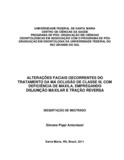| dc.creator | Antoniazzi, Simone Pippi | |
| dc.date.accessioned | 2011-09-23 | |
| dc.date.available | 2011-09-23 | |
| dc.date.issued | 2011-02-28 | |
| dc.identifier.citation | ANTONIAZZI, Simone Pippi. FACIAL CHANGES AFTER THE TREATMENT OF CLASS III
MALOCCLUSION WITH MAXILLARY DEFICIENCY, HIRING RAPID
MAXILLARY EXPANSION AND FACEMASK THERAPY. 2011. 73 f. Dissertação (Mestrado em Odontologia) - Universidade Federal de Santa Maria, Santa Maria, 2011. | por |
| dc.identifier.uri | http://repositorio.ufsm.br/handle/1/6076 | |
| dc.description.abstract | Introduction: Treatment with Rapid Maxillary Expansion (RME) and Facemask Therapy (FM) has been reported as one of the most effective forms of treatment for patients with
Class III malocclusion, with maxillary involvement. Objective: To evaluate the cephalometric changes in the facial tegumentary in patients with malocclusion of skeletal Class III with maxillary retrusion, with greater or less extent, immediately after orthopaedic therapy, with RME/FM. Methods: The treatments with RME/FM were
performed by a single operator in a suitably selected sample (10 girls and 6 boys), whose the initial and final data were collected on two times (T0 and T1), evaluating
cephalometric parameters and soft tissue. The experimental phase lasted about 12 months. The data were analyzed and compared statistically (Wilcoxon Test - SPSS 13.0), through descriptive analysis, on changes in facial tissue and bone, and dental conditions. Results: A significant increase in maxillary forward growth, inhibition of
mandibular forward growth, and clockwise rotation of the mandible were observed. The maxillary incisors were significantly proclined and the mandibular incisors significantly retroclined. Conclusion: Changes produced in the midface were clinically and cephalometric observed, demonstrating anterior displacement of maxilla and point "A", improvement in facial convexity, correction of the anterior crossbite, increase in the overbite and overjet. However, more studies are needed, since the information in the literature are still inconclusive, given the divergent findings and consensus between
authors. | eng |
| dc.format | application/pdf | por |
| dc.language | por | por |
| dc.publisher | Universidade Federal de Santa Maria | por |
| dc.rights | Acesso Aberto | por |
| dc.subject | Aparelhos de tração extrabucal | por |
| dc.subject | Tração reversa da maxila | por |
| dc.subject | Máscara facial | por |
| dc.subject | Cefalometria | por |
| dc.subject | Má oclusão de classe III | por |
| dc.subject | Extraoral traction appliances | eng |
| dc.subject | Maxillary protraction | eng |
| dc.subject | Facemask | eng |
| dc.subject | Cephalometry | eng |
| dc.subject | Class III malocclusion | eng |
| dc.title | Alterações faciais decorrentes do tratamento da má
oclusão de classe III, com deficiência de maxila,
empregando disjunção maxilar e tração reversa | por |
| dc.title.alternative | Facial changes after the treatment of class III
malocclusion with maxillary deficiency, hiring rapid
maxillary expansion and facemask therapy | eng |
| dc.type | Dissertação | por |
| dc.description.resumo | Introdução: O tratamento Ortodôntico com Expansão Rápida da Maxila (ERM) e Tração Reversa (TR) tem sido descrito na literatura como uma das mais eficazes formas de tratamento, para pacientes portadores de má oclusão de Classe III, com
envolvimento maxilar. Objetivo: Avaliar as alterações cefalométricas e no tegumento da facial, em pacientes portadores de má oclusão de Classe III esquelética, com retrusão maxilar em maior ou menor grau, imediatamente após o tratamento com ERM/TR. Metodologia: Os tratamentos com ERM/TR foram realizados pelo pesquisador, em uma amostra convenientemente selecionada, sem distinção de gênero (10 meninas e 6 meninos), jovens, com necessidade de tratamento, onde os dados iniciais e finais foram coletados em dois momentos (T0 e T1), avaliando parâmetros cefalométricos ósseos e de tecidos moles. O período experimental foi de aproximadamente 12 meses. Os
resultados foram analisados e comparados estatisticamente (Teste de Wilcoxon - SPSS 13.0), por meio de análises descritivas, quanto às alterações ósseas e no tegumento
facial, e quanto às modificações dentárias. Resultados: Significante aumento no crescimento anterior da maxila, limitação do crescimento anterior da mandíbula, rotação
mandibular no sentido horário. Incisivos maxilares foram significativamente proclinados e incisivos mandibulares retroinclinados. Conclusão: As alterações produzidas na face
média foram clinica e cefalometricamente observadas, demonstrando anteriorização da maxila e do ponto A , melhora na convexidade facial, correção do cruzamento anterior, viabilização de sobremordida e sobressaliência positivas. Entretanto, mais estudos são necessários, visto que as informações existentes na literatura ainda são pouco
conclusivas, dadas as divergências de achados e de consenso entre autores. | por |
| dc.contributor.advisor1 | Grehs, Renésio Armindo | |
| dc.contributor.advisor1Lattes | http://buscatextual.cnpq.br/buscatextual/visualizacv.do?id=K4229991T6 | por |
| dc.contributor.referee1 | Ferrazzo, Vilmar Antonio | |
| dc.contributor.referee1Lattes | http://buscatextual.cnpq.br/buscatextual/visualizacv.do?id=K4790212T7 | por |
| dc.contributor.referee2 | Régio, Miguel Roberto Simões | |
| dc.contributor.referee2Lattes | http://buscatextual.cnpq.br/buscatextual/visualizacv.do?id=K4759361Z6 | por |
| dc.creator.Lattes | http://buscatextual.cnpq.br/buscatextual/visualizacv.do?id=K4771371J3 | por |
| dc.publisher.country | BR | por |
| dc.publisher.department | Odontologia | por |
| dc.publisher.initials | UFSM | por |
| dc.publisher.program | Programa de Pós-Graduação em Ciências Odontológicas | por |
| dc.subject.cnpq | CNPQ::CIENCIAS DA SAUDE::ODONTOLOGIA | por |


